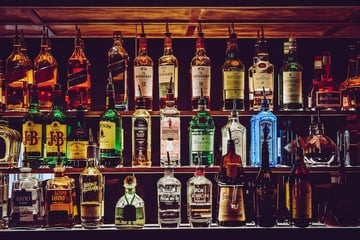 Mixing Business and Pleasure: How the Best Liquor Inventory App Redefines Bar Management
Mixing Business and Pleasure: How the Best Liquor Inventory App Redefines Bar Management
In the dynamic world of bars and nightclubs, efficient liquor and bar control are paramount for success. The advent of technology has ushered in a new era of management tools, and the search for the Best Liquor Inventory App and Best Bar Inventory App is a strategic move toward achieving excellence. This article delves into the transformative impact of the Best Liquor Inventory App on bar management, redefining how establishments approach liquor control and overall efficiency.
The Essence of the Best Liquor Inventory App
Precision in Liquor Control is the linchpin of effective bar management, and the Best Liquor Inventory App stands as a beacon of innovation in achieving this goal. Traditional manual tracking methods often fall short in the face of rapidly changing demands and the need for real-time insights.
The Best Liquor Inventory App elevates the game by offering meticulous real-time tracking of every drop of alcohol. This not only minimizes the risks associated with over-pouring and potential theft but also provides invaluable data for strategic decision-making. Bar managers can now identify top-performing products, adjust pricing strategies, and optimize purchasing decisions to enhance overall profitability.
Revolutionizing Operations with the Best Bar Inventory App
Efficiency is the heartbeat of any successful bar or nightclub, and the quest for the Best Bar Inventory App is a significant step toward achieving streamlined operations. Traditional inventory management methods often lead to time-consuming processes and potential errors that hinder the seamless operation of a bustling establishment.
The Best Bar Inventory App revolutionizes day-to-day operations by eliminating manual stock counts and data entry. With real-time updates on inventory levels, staff can quickly identify available drinks, reducing the risk of stockouts during peak hours. Automated alerts for low stock levels further streamline the reordering process, saving time and ensuring a constant flow of inventory.
Best Liquor Inventory App, Best Bar Inventory App, Liquor Control, Bar Control
For establishments seeking to excel in the competitive nightlife landscape, the adoption of the Best Liquor Inventory App is not just an upgrade—it's a strategic move toward achieving excellence in liquor control. By leveraging this advanced technology, bars and nightclubs can streamline operations, minimize losses, and foster an environment of accountability.
The data-driven insights provided by the Best Liquor Inventory App empower managers to make informed decisions, from product offerings to pricing strategies, ultimately leading to enhanced profitability. In the vibrant and competitive world of bars and nightclubs, embracing the potential of the Best Liquor Inventory App is the key to not just staying ahead but thriving at the forefront of success.
In conclusion, the Best Liquor Inventory App is a game-changer for bar management. By redefining how liquor control is approached, it enables establishments to mix business and pleasure seamlessly. For bars and nightclubs aspiring to elevate their operations, this technology is not just an investment—it's a recipe for sustained excellence in the dynamic and evolving landscape of the nightlife industry.
Liquor Inventory Experts
Topics: Bar inventory, Bar Management, Bar Promotion, bar inventory app, liquor inventory app, Best Bar Inventory app, Best Liquor Inventory app
Maximizing Returns: How the Best Liquor Inventory App and Bar Inventory App Redefine Liquor and Bar Control
In the thriving realm of bars and nightclubs, the pursuit of operational excellence is synonymous with success. Today, achieving the highest level of efficiency and profitability hinges on leveraging cutting-edge technology, particularly through the adoption of the Best Liquor Inventory App and Bar Inventory App. This article explores the transformative role of these apps in redefining liquor and bar control and maximizing returns for establishments in the dynamic nightlife industry.
The Essence of the Best Liquor Inventory App
Precision in Liquor Control is the linchpin of effective bar management. Manual tracking methods are not only time-consuming but also prone to inaccuracies that can lead to significant losses. The Best Liquor Inventory App emerges as a solution to revolutionize liquor control by offering real-time tracking capabilities.
With the Best Liquor Inventory App, every ounce of alcohol is meticulously monitored, mitigating the risks of over-pouring and potential theft. This heightened level of precision not only ensures accurate liquor control but also equips managers with valuable data for strategic decision-making. From identifying top-selling products to optimizing purchasing strategies, this app becomes an indispensable tool for enhancing profitability.
Efficiency Unleashed: The Best Bar Inventory App
Efficiency is the lifeblood of any successful bar or nightclub, and the quest for the Best Bar Inventory App is a strategic move toward achieving operational excellence. Traditional inventory management methods often fall short in the face of high demand, leading to inefficiencies and customer dissatisfaction.
The Best Bar Inventory App revolutionizes operations by eliminating the need for labor-intensive manual stock counts and data entry. Real-time updates on inventory levels empower staff to quickly identify available drinks, reducing the risk of stockouts during peak hours. Automated alerts for low stock levels streamline the reordering process, saving time and ensuring a constant flow of inventory.
Harmonizing for Optimal Liquor and Bar Control
The synergy between the Best Liquor Inventory App and the Best Bar Inventory App establishes a harmonious environment for optimal liquor and bar control. These apps complement each other to provide the highest level of precision and efficiency.
While the Best Liquor Inventory App ensures meticulous tracking of every drop of alcohol, preventing losses and providing actionable insights, the Best Bar Inventory App streamlines day-to-day operations. Together, they create a robust system that not only ensures a secure and accountable bar environment but also enhances overall efficiency.
Best Liquor Inventory App, Best Bar Inventory App, Liquor Control, Bar Control
For establishments committed to maximizing returns in the competitive nightlife scene, leveraging the Best Liquor Inventory App and Best Bar Inventory App is not just a technological upgrade; it's a strategic investment in success. By curbing losses, streamlining operations, and fostering efficiency, these apps contribute to a more secure and accountable bar environment.
The data-driven insights provided by these apps empower managers to make informed decisions, from pricing strategies to product offerings, ultimately leading to enhanced profitability. In the fiercely competitive landscape of bars and nightclubs, embracing the potential of the Best Liquor Inventory App and Best Bar Inventory App is the key to not just staying relevant but thriving at the forefront of success. Establishments that prioritize these innovative technologies position themselves for sustained excellence and profitability in the dynamic nightlife industry.
Topics: bar inventory app, liquor inventory app, Best Bar Inventory app, Best Liquor Inventory app
Unleashing Success: Unlocking the Potential of the Best Liquor Inventory App and Bar Inventory App for Optimal Liquor and Bar Control In the fast-evolving landscape of bars and nightclubs, staying ahead of the competition requires a strategic embrace of technology. The quest for the Best Liquor Inventory App and the Best Bar Inventory App has become integral to achieving optimal liquor and bar control. This article delves into the importance of these apps in fostering efficiency, reducing losses, and establishing a robust foundation for success in the dynamic world of nightlife.
In the fast-evolving landscape of bars and nightclubs, staying ahead of the competition requires a strategic embrace of technology. The quest for the Best Liquor Inventory App and the Best Bar Inventory App has become integral to achieving optimal liquor and bar control. This article delves into the importance of these apps in fostering efficiency, reducing losses, and establishing a robust foundation for success in the dynamic world of nightlife.
The Significance of the Best Liquor Inventory App
Achieving precise Liquor Control is a cornerstone of successful bar management. Manual inventory tracking methods are prone to errors and time-consuming, often leaving room for inefficiencies and losses. The Best Liquor Inventory App transforms this scenario by offering real-time tracking capabilities.
With the Best Liquor Inventory App, every drop of alcohol is meticulously tracked, reducing the risk of over-pouring and theft. This level of precision not only ensures accurate liquor control but also provides valuable data for strategic decision-making. Managers can analyze consumption patterns, identify top-performing products, and optimize purchasing strategies for enhanced profitability.
Unleashing Efficiency with the Best Bar Inventory App
Efficiency is the heartbeat of any well-run bar or nightclub, and the search for the Best Bar Inventory App is a crucial step toward achieving this efficiency. Traditional inventory management methods are labor-intensive and prone to errors, hindering the seamless operation of a bustling establishment.
The Best Bar Inventory App revolutionizes operations by eliminating manual stock counts and data entry. It provides real-time updates on inventory levels, empowering staff to quickly identify available drinks and reducing the risk of stockouts during peak hours. Automated alerts for low stock levels streamline the reordering process, saving time and ensuring a continuous flow of inventory.
Harmony in Optimal Liquor and Bar Control
The integration of the Best Liquor Inventory App and the Best Bar Inventory App creates a harmonious environment for optimal liquor and bar control. These apps work together to provide the highest level of precision and efficiency.
The Best Liquor Inventory App ensures every ounce of alcohol is tracked in real-time, preventing losses and providing valuable insights. Meanwhile, the Best Bar Inventory App streamlines operations, reduces the chances of errors, and ensures that the bar is well-stocked to meet customer demands.
**SEO Keywords: Best Liquor Inventory App, Best Bar Inventory App, Liquor Control, Bar Control**
For establishments aiming to dominate the nightlife scene, utilizing the Best Liquor Inventory App and Best Bar Inventory App is not just about modernization; it's a strategic move toward unleashing success. By curbing losses, streamlining operations, and fostering efficiency, these apps contribute to a more secure and accountable bar environment.
The data-driven insights provided by these apps empower managers to make informed decisions, from pricing strategies to product offerings, ultimately leading to enhanced profitability. In the competitive realm of nightlife, embracing the potential of the Best Liquor Inventory App and Best Bar Inventory App is the key to staying at the forefront of success. Establishments that invest in these innovative technologies are not just modernizing; they are positioning themselves for sustained excellence in the dynamic and competitive landscape of bars and nightclubs.
Topics: liquor inventory, Bar inventory, managing liquor inventory cost, liquor inventory timing, Best Bar Inventory app, Best Liquor Inventory app
 Safeguarding Spirits and Savings: Finding the Best Liquor Inventory App and Bar Inventory App
Safeguarding Spirits and Savings: Finding the Best Liquor Inventory App and Bar Inventory App
In the fast-paced world of bars and nightclubs, the pursuit of efficiency and profitability is unending. To navigate this high-energy environment, many bar and nightclub owners are turning to technology for solutions, particularly the quest to find the Best Liquor Inventory App and the Best Bar Inventory App. In this article, we'll explore the importance of these apps in safeguarding spirits and savings, as well as enhancing liquor control and bar control.
The Significance of the Best Liquor Inventory App
A Liquor Inventory App is a vital component of efficient liquor control in any bar or nightclub. Manual inventory management methods are not only time-consuming but also prone to human errors, making it challenging to keep up with the ever-evolving demands of the industry.
The Best Liquor Inventory App offers real-time tracking of every drop of alcohol in an establishment. This precision ensures that every bottle and keg is meticulously tracked, thereby reducing the risk of over-pouring, spillage, and theft. The result is more precise liquor control, which serves as the foundation for more profitable operations.
Discovering the Best Bar Inventory App for Streamlined Operations
Efficiency is the lifeblood of a well-managed bar or nightclub, and the search for the Best Bar Inventory App plays a critical role in achieving this goal. This technology eliminates the need for time-consuming manual stock counts and data entry, enabling staff to focus on what they do best—serving customers.
The Best Bar Inventory App provides real-time updates on inventory levels, allowing staff to quickly identify available drinks. This minimizes the risk of running out of popular spirits during peak hours, ensuring customer satisfaction and maintaining revenue streams. Moreover, automated alerts for low stock levels simplify the reordering process, eliminating the stress associated with traditional inventory management.
The Quest for the Best: Optimal Liquor and Bar Control
When it comes to liquor and bar control, finding the Best Liquor Inventory App and the Best Bar Inventory App is essential. These apps work in tandem to offer the highest level of precision and efficiency.
The Best Liquor Inventory App ensures that every ounce of alcohol is tracked in real time, minimizing the chances of over-pouring and theft. It also provides data-driven insights into consumption patterns, allowing managers to make informed purchasing decisions.
The Best Bar Inventory App eliminates the need for manual stock counts and data entry, streamlining operations and improving customer service. It also simplifies the reordering process with automated alerts for low stock levels.
Safeguarding Spirits and Savings
In conclusion, the pursuit of the Best Liquor Inventory App and the Best Bar Inventory App is crucial for safeguarding spirits and savings in the bar and nightclub industry. These innovative digital tools provide precise control over liquor inventory and streamline operations, ultimately enhancing profitability.
By preventing over-pouring, theft, and unauthorized consumption, these apps create a more secure and accountable bar environment. Additionally, the data-driven insights they offer empower bar managers to optimize their offerings, make informed purchasing decisions, and enhance profitability.
Investing in the Best Liquor Inventory App and the Best Bar Inventory App is not just a matter of modernization; it's a strategic move toward safeguarding spirits, ensuring savings, and establishing a more efficient and successful bar or nightclub. In the competitive world of nightlife, these apps are the key to staying ahead.
Topics: Bar inventory, Scannabar Inventory system, Liquor Inventory savings, Best Bar Inventory app, Best Liquor Inventory app
Crafting Cocktails and Curbing Losses: The Role of a Bar Inventory App
In the world of bars and nightclubs, precision and control are key to success. The modern bar and nightclub industry is dynamic, and with rapidly changing customer preferences, managing inventory and operations efficiently is essential. This is where Bar Inventory Apps come into play, serving as a critical tool in curbing losses, enhancing liquor control, and crafting exceptional cocktails. In this article, we'll explore the pivotal role of Bar Inventory Apps in modern bar management.
Elevating Liquor Control with a Bar Inventory App
A Bar Inventory App is designed to empower bar owners and managers with real-time tracking and control over their liquor inventory. In a fast-paced environment like a bar or nightclub, traditional manual inventory management can be both time-consuming and prone to errors. These issues are particularly problematic when dealing with high-demand items and managing bartender performance.
Bar Inventory Apps bring a new level of precision to liquor control. They allow bar staff to track every drop of alcohol in real time, ensuring that nothing is unaccounted for. This accuracy not only prevents over-pouring and potential theft but also provides valuable data for strategic decision-making.
Streamlining Operations and Efficiency
Efficiency is a buzzword in the bar and nightclub industry, and Bar Inventory Apps play a significant role in achieving it. In busy establishments, every moment counts, and the app eliminates the need for labor-intensive manual stock counts and guesswork.
With real-time updates on inventory levels, bar staff can quickly identify which drinks are available, reducing the risk of running out of popular spirits during peak hours. This level of efficiency is critical for maintaining customer satisfaction and revenue.
Automated alerts for low stock levels simplify the reordering process. This feature ensures that orders are placed promptly, minimizing the chances of stockouts and lost revenue due to understocking. The app not only saves time but also reduces the stress associated with traditional inventory management.
Enhancing Bartender Performance and Accountability
Bar Inventory Apps also contribute to enhancing bartender performance and accountability. These apps record every transaction, from orders to sales, creating a transparent system that promotes accountability. By providing a digital record of each pour, they serve as a deterrent to over-pouring and unauthorized consumption, which can contribute to significant losses.
Additionally, the data generated by these apps allows bar managers to identify trends and patterns in bartender performance. This information can be used for training and improvement, ensuring that all staff members are contributing to the establishment's success.
The Bottom Line: More Profitable Bars and Nightclubs
In conclusion, Bar Inventory Apps are a game-changer for modern bars and nightclubs. These digital tools provide precise control over liquor inventory, streamline operations, and curb losses. By preventing over-pouring, theft, and unauthorized consumption, these apps foster a more secure and accountable bar environment.
Moreover, the data-driven insights from Bar Inventory Apps empower bar managers to optimize their offerings, make informed purchasing decisions, and ultimately enhance profitability. The result is a more efficient and successful bar or nightclub that caters to customer preferences, all while maintaining a competitive edge in a challenging market.
Investing in a Bar Inventory App is not just a move toward modernization; it's a strategic step toward crafting exceptional cocktails, curbing losses, and ensuring long-term profitability in the bar and nightclub industry.
Topics: liquor inventory, Bar inventory, Scannabar Inventory system, liquor inventory system, bar inventory software, bar inventory app, liquor inventory app
Cheers to Efficiency: Streamlining Nightclub Operations with a Liquor Inventory App
Efficiency and precision in liquor and bar management are paramount in the bustling world of nightclubs. To succeed in this high-energy environment, nightclub owners are turning to advanced tools like Liquor Inventory Apps and Bar Inventory Apps. These innovative digital solutions are reshaping the way nightclubs are run, enhancing liquor control, and optimizing bar management. In this article, we'll explore how these apps are contributing to a more efficient nightclub operation.
Elevating 
The foundation of any nightclub's success lies in its ability to control liquor inventory with precision. Traditional manual methods of tracking bottles and kegs often fall short in this fast-paced setting. Liquor Inventory Apps offer an alternative that's revolutionizing the industry.
With a Liquor Inventory App, nightclub owners and managers can enjoy real-time tracking of every drop of alcohol in their establishment. This real-time data isn't just for show; it ensures the accuracy of liquor control. Every ounce is accounted for, minimizing the risk of over-pouring, spillage, and potential theft. It's this level of precision that forms the basis of efficient liquor management.
Streamlining Bar Control with a Bar Inventory App
Efficiency is a nightclub's best friend, and a Bar Inventory App plays a pivotal role in achieving that efficiency. In a fast-paced nightclub, every moment counts. The app eliminates the need for labor-intensive manual stock counts and data entry.
One of the primary advantages of a Bar Inventory App is that it provides real-time updates on inventory levels. Nightclub staff can easily and quickly determine which drinks are available, eliminating the risk of running out of popular spirits during peak hours. This enhanced efficiency is not only vital for customer satisfaction but also reduces stress associated with traditional inventory management.
The app also streamlines the reordering process. Automated alerts for low stock levels ensure that orders are placed promptly, reducing the chances of stockouts. This level of automation not only saves time but also prevents lost revenue due to understocking.
The Synergy of Liquor and Bar Control
When a nightclub integrates both a Liquor Inventory App and a Bar Inventory App, the results are transformative. Imagine having precise insights into which drinks are your top sellers and being able to adjust pricing or promotions accordingly. With real-time data at your disposal, nightclub managers can optimize their offerings, ultimately maximizing revenue while keeping customers satisfied.
These apps also promote a culture of accountability. By digitally tracking every transaction, from orders to sales, they deter employee theft and unauthorized consumption. This not only creates a more secure environment but also fosters trust among staff members, contributing to smoother operations.
In conclusion, the implementation of Liquor Inventory Apps and Bar Inventory Apps is a game-changer for the nightclub industry. These digital tools empower nightclub owners to take precise control of their liquor inventory, streamline operations, make informed purchasing decisions, and ultimately enhance profitability. The result is a well-organized, efficient, and secure establishment that caters to the dynamic needs of nightclub-goers while staying competitive in a tough market. If you're looking to streamline your nightclub operations and boost efficiency, these innovative apps are the way to go. Cheers to a more efficient and profitable nightclub operation!
Topics: Bar inventory, Hotel Inventory, NightClub Management, Bar Management, Liquor Inventory savings, bar inventory app, liquor inventory app
From Bottles to Bytes: Modernizing Bar Control with a Liquor Inventory App The traditional methods of liquor control and bar management have given way to a new era, one that revolves around digital innovation. As bars and nightclubs strive for efficiency and profitability, Liquor Inventory Apps and Bar Inventory Apps are taking center stage. In this article, we'll explore how these apps are redefining bar control and liquor management.
The traditional methods of liquor control and bar management have given way to a new era, one that revolves around digital innovation. As bars and nightclubs strive for efficiency and profitability, Liquor Inventory Apps and Bar Inventory Apps are taking center stage. In this article, we'll explore how these apps are redefining bar control and liquor management.
Embracing Technology for Precise Liquor Control
The heart of any bar operation lies in the control of its liquor inventory. Traditional methods of tracking bottles and kegs have proven time-consuming, prone to human error, and difficult to keep up with the dynamic demands of the industry. Enter the Liquor Inventory App, a digital solution that changes the game.
With a Liquor Inventory App, every ounce of alcohol is meticulously tracked in real-time. This real-time tracking doesn't just provide accurate data on-hand; it also minimizes over-pouring, spillage, and theft. The result? More precise control over your liquor inventory, ensuring that every drop is accounted for. This level of accuracy is the foundation for efficient liquor management.
Efficiency in Bar Control through a Bar Inventory App
Efficiency is the key to a successful bar operation, and a Bar Inventory App is an indispensable tool for achieving this goal. This technology streamlines bar control in several ways.
Firstly, it eliminates the need for manual stock counts and data entry. With real-time inventory updates, bar staff can easily see what's available, reducing the chances of running out of popular drinks during peak hours. This enhanced efficiency not only improves customer service but also eliminates the stress associated with traditional inventory management.
Secondly, the app streamlines the reordering process. Automated alerts for low stock levels ensure that orders are placed in a timely manner, reducing the risk of stockouts. This not only saves time but also prevents lost revenue due to understocking.
The Symbiosis of Liquor and Bar Control
When Liquor Inventory Apps and Bar Inventory Apps work in tandem, the synergy is undeniable. Imagine having precise data on which drinks are your best-sellers and being able to adjust pricing or promotions accordingly. With real-time insights, bar managers can optimize their offerings, ultimately maximizing revenue while keeping customers satisfied.
Furthermore, these apps foster a culture of accountability. By digitally tracking every transaction, from orders to sales, they act as a deterrent to employee theft and unauthorized consumption. This ensures a more secure business environment, builds trust among staff members, and enhances overall bar control.
In conclusion, the integration of Liquor Inventory Apps and Bar Inventory Apps represents a modern approach to bar control and liquor management. These digital tools provide accurate and real-time insights into inventory levels, streamline operations, reduce wastage, and enhance profitability. Bars and nightclubs that embrace this technology gain a competitive edge in an industry known for its dynamism and tough competition. If you're looking to bring your bar into the digital age and modernize your operations, consider the implementation of these innovative apps. Raise your glasses to more efficient and profitable bar control!
Topics: Bar inventory, managing liquor inventory cost, bar control, liquor control, bar inventory app, liquor inventory app
In the world of bars and nightclubs, maintaining precise Liquor Control and efficient Bar Control is essential for profitability. One revolutionary tool that's transforming the way these establishments manage their operations is the Liquor Inventory App and Bar Inventory App. Let's delve into how these apps are helping bars boost their bottom lines by enhancing liquor and bar control.
Precision in Liquor Control with a Liquor Inventory App
A Liquor Inventory App offers a level of precision in liquor control that was once unimaginable. Traditional manual inventory methods are not only labor-intensive but also susceptible to human error. With a Liquor Inventory App, every drop of liquor is meticulously tracked in real-time. This means that every bottle, keg, or case of spirits is accounted for with pinpoint accuracy, greatly reducing the chances of over-pouring or theft.
Moreover, these apps provide data-driven insights into liquor consumption patterns. Bar managers can access real-time data on which spirits are in high demand and which are not. Armed with this information, they can make informed purchasing decisions, ensuring that the bar is always stocked with the right products. This optimization results in reduced wastage, more efficient storage, and, ultimately, higher profitability.
Efficiency in Bar Control with a Bar Inventory App
Efficiency is the lifeblood of a well-run bar, and a Bar Inventory App is a game-changer in this regard. It eliminates the need for manual stock counts and guesswork, allowing bar staff to focus on what they do best—serving customers. Real-time updates on inventory levels ensure that staff always know what's available, reducing the risk of running out of essential supplies during peak hours.
The efficiency extends to ordering and restocking as well. With a Bar Inventory App, managers can set up automated alerts for low stock levels, guaranteeing a steady flow of inventory without interruptions. This streamlined approach not only saves time but also minimizes the stress and potential lost revenue associated with stockouts.
The Profitable Synergy of Liquor and Bar Control
When a Liquor Inventory App and a Bar Inventory App work together, the result is a powerful synergy that enhances both liquor and bar control. Imagine having comprehensive insights into which drinks are your top sellers, allowing you to adjust pricing or promotions accordingly. With real-time data at your fingertips, you can develop pricing strategies that maximize revenue while providing value to customers.
These apps also play a crucial role in promoting accountability. By digitally tracking every transaction, from orders to sales, they deter employee theft and unauthorized consumption. This creates a more secure environment and builds trust among staff members, contributing to smoother operations.
In conclusion, the integration of a Liquor Inventory App and a Bar Inventory App is a game-changer for the bar and nightclub industry. These digital tools empower bar owners to take precise control of their liquor inventory, streamline operations, make data-driven purchasing decisions, and ultimately enhance profitability. The result is a well-organized, efficient, and secure establishment that caters to patrons' preferences while maximizing its bottom line. If you're looking to pour profits into your bar business, investing in these innovative apps is the way to go. Cheers to a more prosperous future for your establishment!
Topics: Bar inventory, Scannabar Inventory system, Bar Management, alcohol cost, Reducing Liquor Costs
Mastering Mixology and Margins: The Power of a Liquor Inventory App
In the competitive world of bars and nightclubs, the art of mixology and efficient liquor control are paramount for success. To master this balancing act, savvy bar owners are turning to Liquor Inventory Apps and Bar Inventory Apps. These digital tools are becoming the secret ingredients that transform bar management, ensuring optimal control over liquor and bar operations. Let's explore how these apps are changing the game, empowering establishments to mix the perfect cocktail of success.
Precise Liquor Control with a Liquor Inventory App
A Liquor Inventory App is a bartender's best friend when it comes to precise liquor control. Traditional manual inventory methods are not only time-consuming but also prone to errors. With a Liquor Inventory App, each drop of liquor is meticulously tracked in real time. This digital solution ensures that every bottle and keg is accounted for, significantly reducing the likelihood of over-pouring or theft.
Moreover, these apps provide data-driven insights into liquor consumption patterns. Bar managers can access real-time data on which spirits are in high demand and which ones are lagging behind. Armed with this information, they can fine-tune their purchasing decisions, ensuring that the bar is always stocked with the right products. This optimization translates into reduced wastage, more efficient storage, and ultimately, higher profitability.
Efficient Bar Control with a Bar Inventory App
Efficiency is the name of the game in the bar and nightclub business, and a Bar Inventory App is the ticket to streamlined bar control. Bar managers can say goodbye to the hassle of manual stock counts and guesswork. With real-time updates on inventory levels, staff can focus on delivering exceptional customer service rather than getting bogged down in inventory tasks.
The efficiency extends beyond inventory management. Bar managers can set up automated alerts for low stock levels, ensuring that orders are placed in a timely fashion. No more last-minute rushes or stockouts that could disappoint customers and impact sales. This improved efficiency not only saves time but also reduces the stress associated with managing a bustling bar.
The Winning Combination: Liquor and Bar Control
When you combine the capabilities of a Liquor Inventory App and a Bar Inventory App, you get a winning formula for liquor and bar control. Imagine having a complete understanding of which drinks are your top sellers and being able to adjust pricing or promotions based on data-backed insights. Bar managers can develop pricing strategies that maximize revenue while ensuring customers receive value for their money.
These apps also play a significant role in promoting accountability. By digitally tracking every transaction, from orders to sales, they act as a deterrent to employee theft and unauthorized consumption. This not only creates a more secure environment but also fosters trust among staff members, which is essential for smooth operations.
In conclusion, the incorporation of a Liquor Inventory App and a Bar Inventory App is a game-changer for the bar and nightclub industry. These digital tools empower bar owners to take precise control of their liquor inventory, streamline operations, make informed purchasing decisions, and ultimately enhance profitability. The result is a well-organized, efficient, and secure establishment that caters to patrons' preferences while staying competitive. If you're looking to master the art of mixology and margins, investing in these innovative apps is the way to go. Cheers to the future of bar management!
Topics: Bar inventory, managing liquor inventory cost, Bar Management, managing liquor costs, bar inventory software, bar inventory app, liquor inventory app
Sipping Success: How a Liquor Inventory App Transforms Bar Management
In the fast-paced world of bars and nightclubs, effective liquor management is the key to success. That's where the power of a Liquor Inventory App and Bar Inventory App comes into play. These innovative digital solutions are revolutionizing the way bars and nightclubs control their inventory and manage their operations. Let's explore how these apps enhance liquor control and bar management for optimal results.
Streamlined Liquor Control with a Liquor Inventory App
A Liquor Inventory App brings a new level of precision to liquor control. Traditional manual inventory methods can be time-consuming, error-prone, and open to discrepancies. With a Liquor Inventory App, every drop of liquor is meticulously tracked in real time. This technology allows bar managers to maintain accurate records of stock levels, ensuring that popular spirits are always available and minimizing the chances of over-pouring or theft.
Furthermore, the app's data-driven insights reveal consumption patterns and identify high-demand items. Armed with this information, bar owners can make informed purchasing decisions, keeping their shelves stocked with the right products at the right times. The result? Reduced wastage, optimized storage space, and ultimately, enhanced profitability.
Efficient Bar Control with a Bar Inventory App
Effective bar control is the cornerstone of a well-managed establishment. A Bar Inventory App empowers bar managers to take control of their inventory processes like never before. By providing real-time updates on stock levels, the app eliminates the need for manual counts and guesswork. Bar staff can focus on what they do best—serving customers—instead of spending excessive time on inventory-related tasks.
This efficiency extends to ordering and restocking as well. With a Bar Inventory App, the days of last-minute rush orders and stockouts are minimized. Managers can set up automated alerts for low stock levels, ensuring a continuous flow of inventory without interruptions. This streamlined approach not only saves time but also reduces stress and potential lost revenue due to insufficient stock.
The Power of Liquor and Bar Control
Combining the capabilities of a Liquor Inventory App and a Bar Inventory App results in powerful liquor and bar control. Imagine knowing exactly which drinks are your top sellers and being able to adjust pricing or promotions accordingly. With comprehensive data insights, bar managers can develop strategic pricing strategies that maximize revenue while keeping customers satisfied.
Moreover, these apps foster a culture of accountability. By digitally tracking every transaction, from orders to sales, they minimize the chances of employee theft and unauthorized consumption. This creates a more secure environment and builds trust among staff members, ultimately contributing to smoother operations.
In conclusion, the integration of a Liquor Inventory App and a Bar Inventory App is a game-changer for the nightlife industry. By embracing these digital tools, bar and nightclub owners can take full control of their liquor inventory, streamline operations, optimize purchasing decisions, and bolster profitability. The result is a well-organized, efficient, and secure establishment that caters to patrons' preferences while staying ahead in a competitive market. Invest in the future of your bar management with these innovative apps, and sip on the success they bring.
Topics: Bar inventory, Scannabar Inventory system, bar supplies, Bar Management, bar inventory system, bar inventory software, bar inventory app


